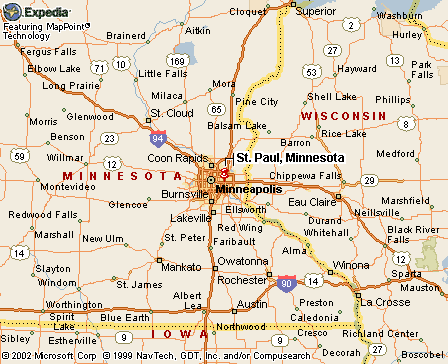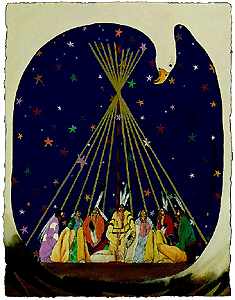 |
Canku Ota
|
 |
|
(Many Paths)
|
||
|
An Online Newsletter
Celebrating Native America
|
||
|
January 1, 2009 - Volume
7 Number 1
|
||
|
|
||
|
Schools are Keeping
the Ojibwe Language Alive
|
||
|
by Megan Boldt - St.
Paul (MN) Pioneer Press
|
||
|
credits: Sam English
|
|
The
effort shows promise for preserving a culture and helping kids academically
Carol Nickaboine pulls out a three-ring binder full of pictures and words, ready to teach the 4-year-olds plopped in front of her a lesson in their native language. 'What is this?' she asks, pointing to a photo of a cow. After some prodding, she helps the children sound out the Ojibwe word 'bizhiki.' 'That's where we get our milk from,' Nickaboine tells the children. 'We get our doodooshaaboo (milk) from a bizhiki.' These students are in a Head Start program run by the Mille Lacs Band of Ojibwe outside of Onamia, Minn. But lessons like Nickaboine's increasingly are being repeated across the United States and Canada from preschool to high school to adult education. The goal is to keep the Ojibwe language and culture from becoming extinct, a fate suffered by other aspects of American Indian life. It's working. In Minnesota schools, enrollment in Ojibwe classes more than tripled from 2001 to 2007 — from 309 students to 1,150. And the benefits go beyond keeping the language alive. Immersion in Ojibwe culture has kept more high-risk students in school, strengthened their connections with their community and, in some cases, boosted their test scores. Anton Treuer, a professor at Bemidji State University who studies the Ojibwe language and oral tradition, sees the growing interest in Ojibwe as a powerful tool. "We are plagued by many serious problems, and I see this as one of the most promising ways to combat them," Treuer said. PRESERVING
LANGUAGE
In 2007, the band opened two charter schools — Minisinaakwaang and Pine Grove leadership academies, which also teach Ojibwe language and culture.At Nay Ah Shing, which has 200 students in K-12, classes include traditional Ojibwe activities such as ricing, netting, trapping and maple sugaring. "Our tribal leaders feel it's very important to make sure our language and culture are preserved and infused into daily life," said Joycelyn Shingobe, education commissioner for the Mille Lacs band. "We've recognized that we're losing people that are fluent in the language." Bemidji State's Treuer estimated that of the 25,000 to 60,000 Americans and Canadians who speak Ojibwe, about 90 percent are elders. Experts say Ojibwe is difficult to learn. Many English letters and sounds don't exist, and there is a double-vowel system. There's also a glottal stop, which is represented by an apostrophe in the written word. The sound is made from the throat, almost like a hitch in the voice. There also is no comprehensive Ojibwe grammar book. That's a project Treuer has worked on for the past 15 years. He has been recording the voices of elders in tribes across the nation and Canada. PRESERVING
TRADITIONS "Their little minds, they're anxious to learn," Kingbird said. For adolescents in high school, Kingbird said, you have to prompt the curiosity a little more. He makes room for plenty of one-on-one time, sits down at the students' level and keeps talking with them in Ojibwe. Nay Ah Shing Principal Eric North said the school tries to infuse Ojibwe culture in a variety of subjects. This fall, for instance, students learned about ricing as part of their science lessons. They went out in canoes, harvested wild rice from a lake and learned how to process it. In class, they discussed how the rice grows in the lake, what kind of conditions the rice needs to grow, parts of the rice plant and how much rice to collect to make a pound of cooked rice. "We try to weave everything together," North said. "They're just like other kids. But by coming here, they might learn some things they can't learn anywhere else." Brandon Anthony, 16, travels 45 miles from Brainerd to go to Nay Ah Shing. The sophomore said he has stronger relationships with the teachers and likes the smaller class sizes compared with his experience in Brainerd public schools. He also enjoys the cultural activities the school offers. Brandon is in the school's drumming class as well as the extracurricular American Indian Business Leaders and the Knowledge Bowl team, which tests students' knowledge of American Indian language and history. "It makes school much more interesting," he said. "I look forward to it." 'IMMERSION
IS THE BEST WAY' "Sometimes they feel like they're being whitewashed," said Treuer. "They feel like they have to worship the other and forget themselves and where they came from in the process. "When kids have an opportunity to learn about their culture and themselves, they gain this self-esteem that spreads to their academics," he said. He said the result is that the kids stay in school and are excited about it. Language-preservation efforts go beyond the reservations. The Mille Lacs band also funds language and cultural programs in such neighboring school districts as Onamia, Isle and McGregor that serve sizable populations of American Indian students. And in St. Paul and Minneapolis, the school districts and charter schools offer Ojibwe language programs starting at the elementary level. St. Paul opened an elementary magnet program for American Indians in 1992 to address dismal test scores, school attendance and graduation rates, said Kathy Denman-Wilke, the district's supervisor of American Indian education. "We felt if we could offer a school that could also focus on their culture, they would be more interested and do better in school," she said. "And they did." The district expanded the program to Battle Creek Junior High and Harding High School in 1994. The schools offer Ojibwe language courses as well as classes in American Indian art, music and history. The elementary magnet program teaches Ojibwe phrases and objects. It also has a Book of the Month program in which elders come in to read and speak to the children. There are three cultural fairs each year. Denman-Wilke said the St. Paul district would love to offer an immersion program, in which the students are taught primarily in Ojibwe, but there aren't enough teachers fluent in the language. "Research shows that immersion is the best way for students to learn the language," Denman-Wilke said. "And if our children are strong in their native culture and language, they tend to do better in school." St. Paul schools received a grant to partner with the Minnesota Humanities Center to develop a K-12 curriculum for Ojibwe and Dakota and to create language-proficiency assessments for use across the state. The district and the humanities center also are creating language kits that include games, DVDs and grammar booklets to encourage families to speak Ojibwe at home. The kits will be given to families in February. Oftentimes, Ojibwe parents don't know the language. "I'm Ojibwe, and I don't speak the language," Denman-Wilke said. "We lost that in my family when my grandmother went to boarding school." Ojibwe tribes also are reaching out to adults who want to learn the language. The Mille Lacs band, for instance, offers an Ojibwe Language Master/Apprentice Program for adults who want to speak the language. Adult students and their families can attend language-immersion camps in the summer, and community members can attend weekly language roundtables to practice the language. "We can teach the language in the school, but when they go home, the language isn't there," Mille Lacs education commissioner Shingobe said. IT'S
ALL ABOUT RESPECT When he was a young man, Kingbird said, he did not want to recognize the meaning behind drumming and dismissed it as a bunch of men screaming and hollering. "I understood what they were doing deep down inside," Kingbird said. "I just didn't want to admit it." Kingbird grew up in Ponemah, Minn., on the Red Lake reservation, one of the most traditional American Indian communities in the state. Even in places like that, Treuer said, only about 10 percent of residents may be fluent in their native language. Kingbird grew up speaking Ojibwe. He said many elders who are fluent were afraid to speak the language publicly because they were ridiculed. Now, it's not taboo, and younger members are embracing the language and culture. "It's changing," Kingbird said. "They're empowering them to come forward. The respect for elders and the culture is really strong and really coming back." Megan Boldt (mboldt@pioneerpress.com) can be reached at 651-228-5495. |
 St. Paul, Minnesota map |
www.expedia.com |
|
|
||
|
|
||
| Canku Ota is a free Newsletter celebrating Native America, its traditions and accomplishments . We do not provide subscriber or visitor names to anyone. Some articles presented in Canku Ota may contain copyright material. We have received appropriate permissions for republishing any articles. Material appearing here is distributed without profit or monetary gain to those who have expressed an interest. This is in accordance with Title 17 U.S.C. Section 107. | ||
|
Canku Ota is a copyright ©
2000, 2001, 2002, 2003, 2004, 2005, 2006, 2007, 2008, 2009 of Vicki
Barry and Paul Barry.
|
||
 |
 |
|
|
The "Canku
Ota - A Newsletter Celebrating Native America" web site and
its design is the
|
||
|
Copyright ©
1999, 2000, 2001, 2002, 2003, 2004, 2005,
2006, 2007, 2008 of Paul C.
Barry.
|
||
|
All Rights Reserved.
|
||
 In
1975, the band opened its own school, Nay Ah Shing. Language preservation
has been a core part of the curriculum from the start. Babies as
young as 6 weeks old hear Ojibwe in the day care programs. Fluent
speakers teach infants through 12th-graders every day.
In
1975, the band opened its own school, Nay Ah Shing. Language preservation
has been a core part of the curriculum from the start. Babies as
young as 6 weeks old hear Ojibwe in the day care programs. Fluent
speakers teach infants through 12th-graders every day.